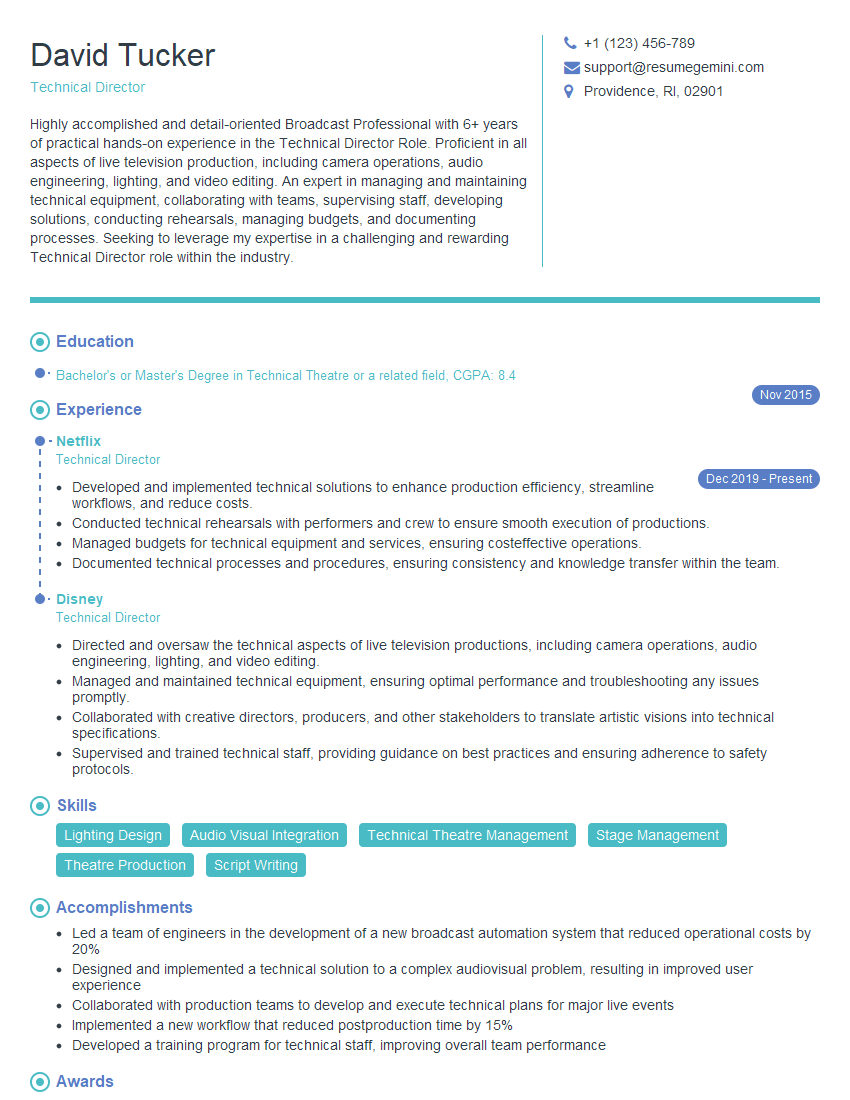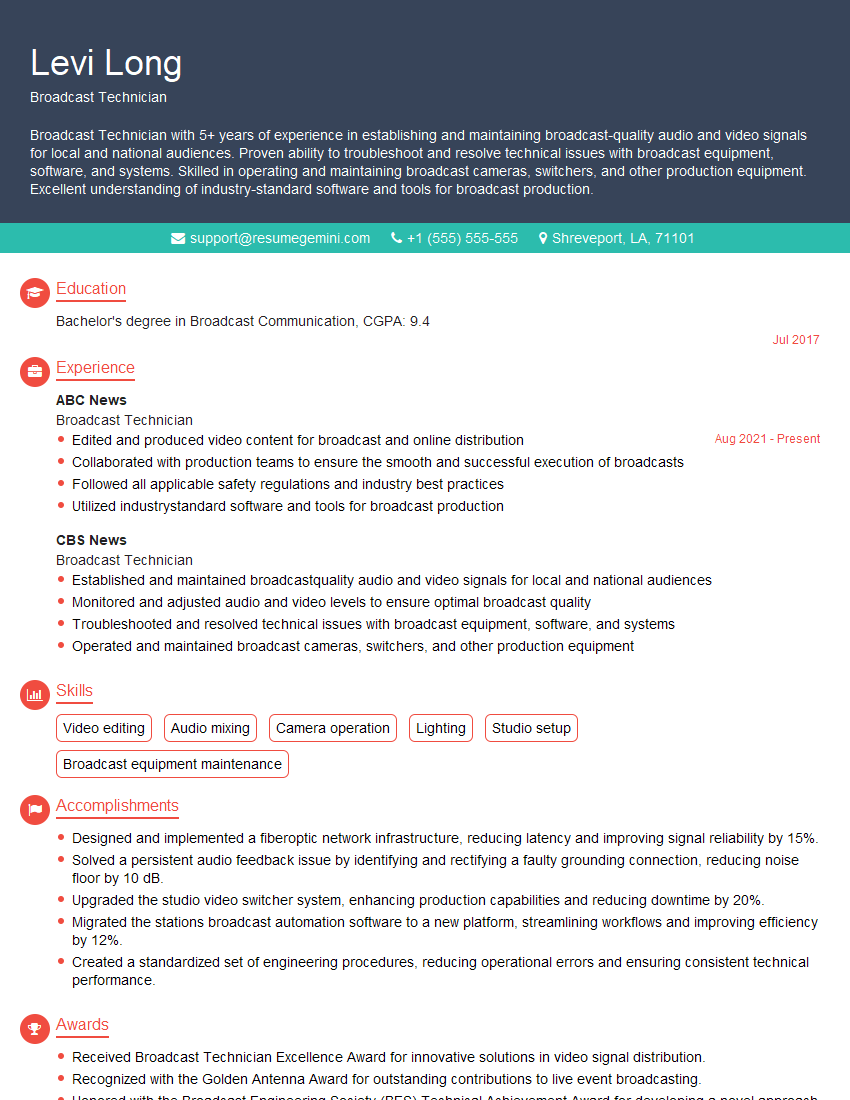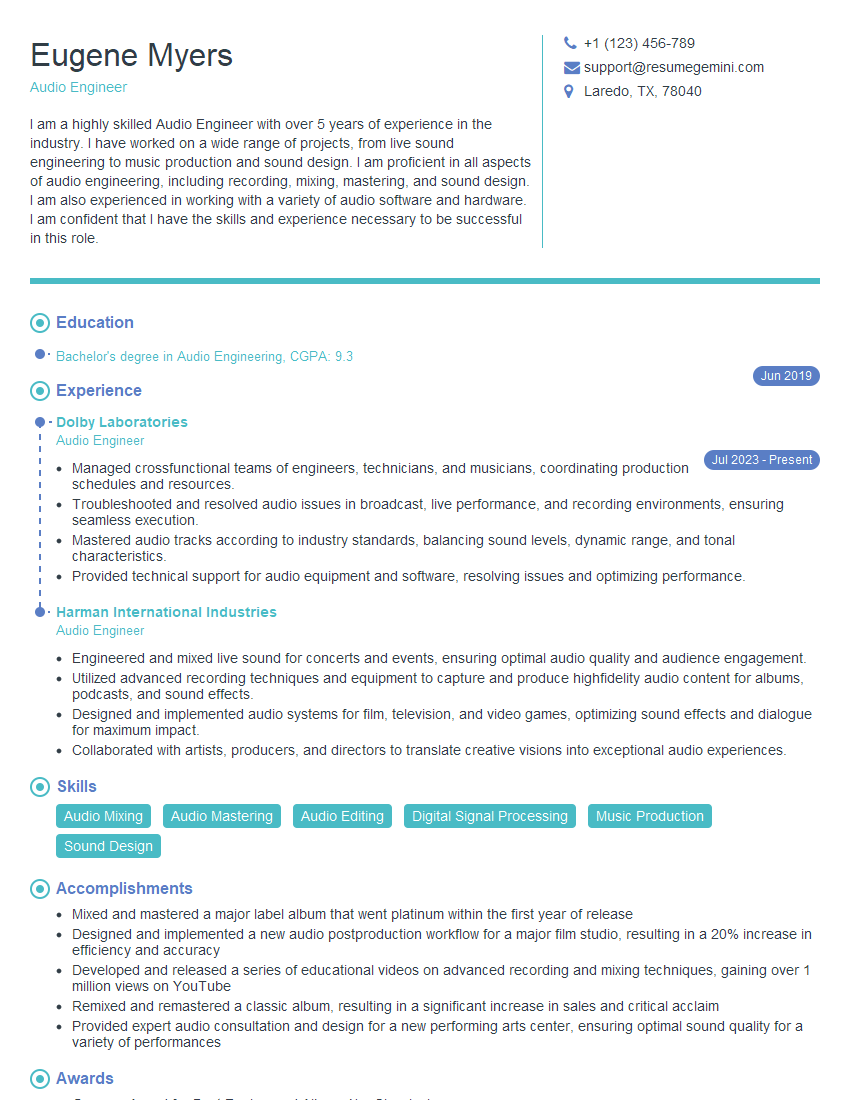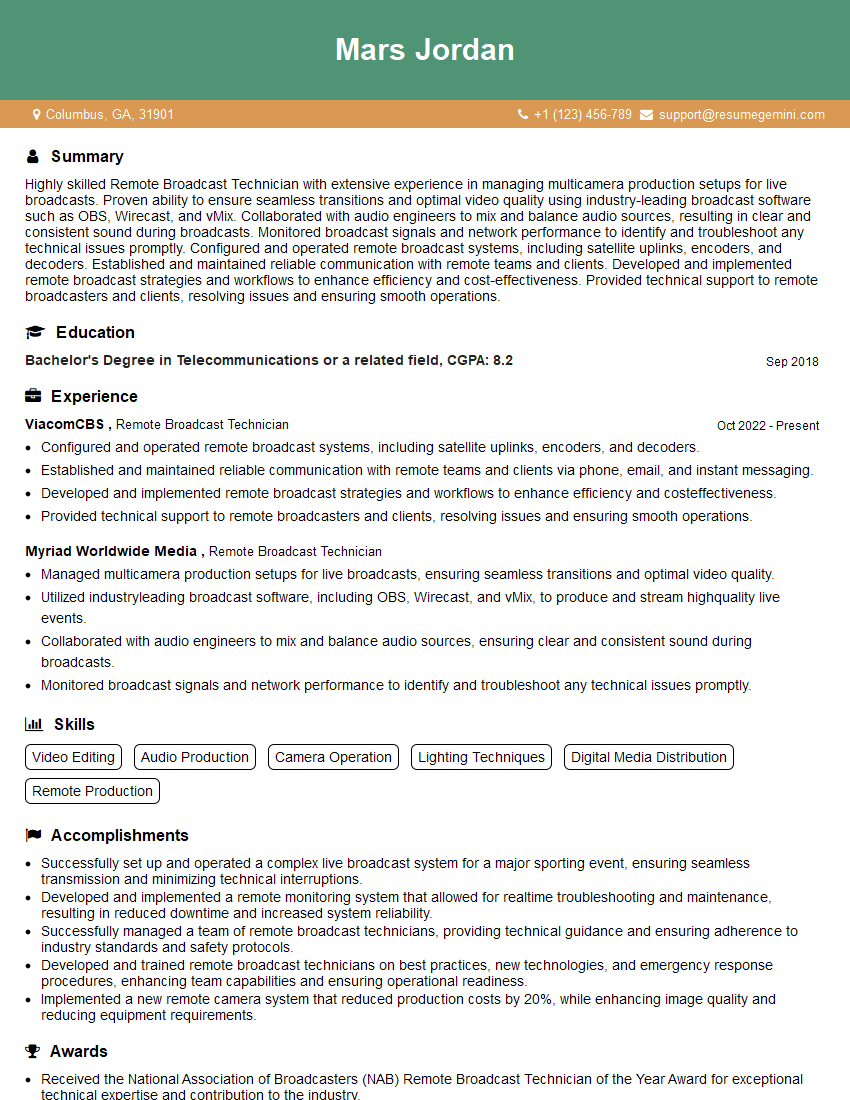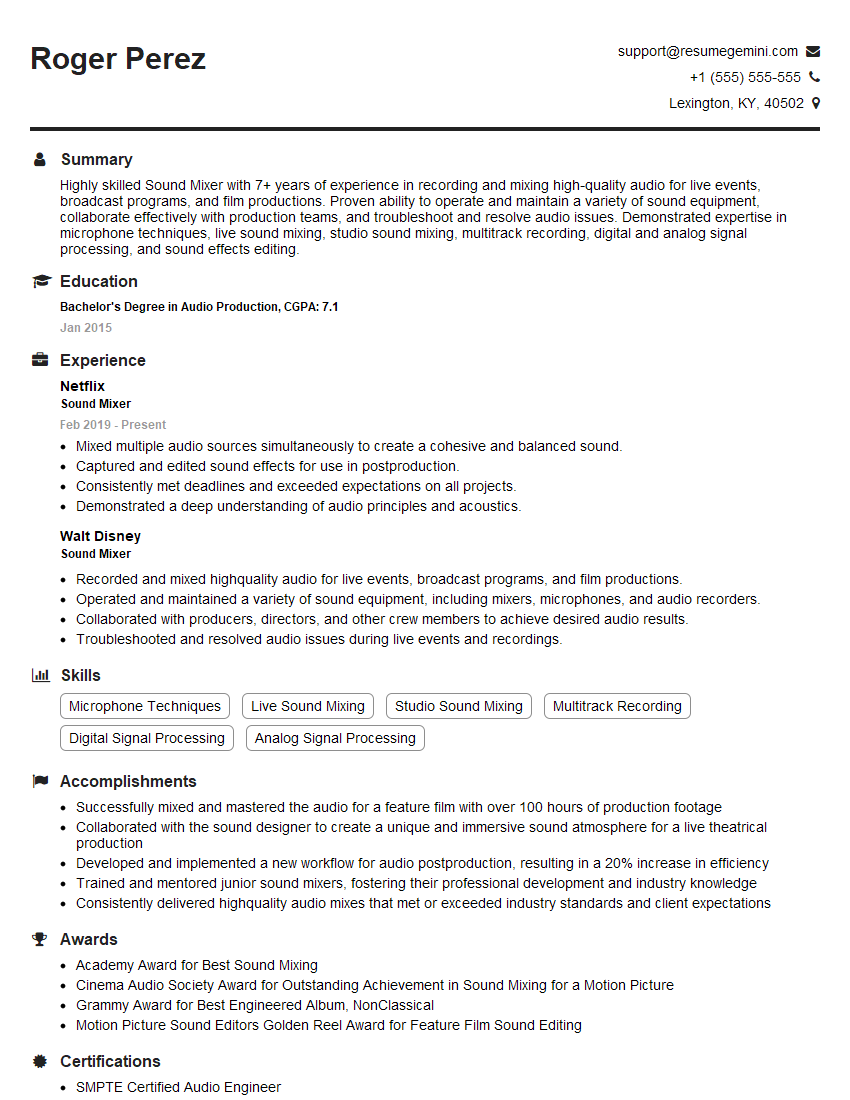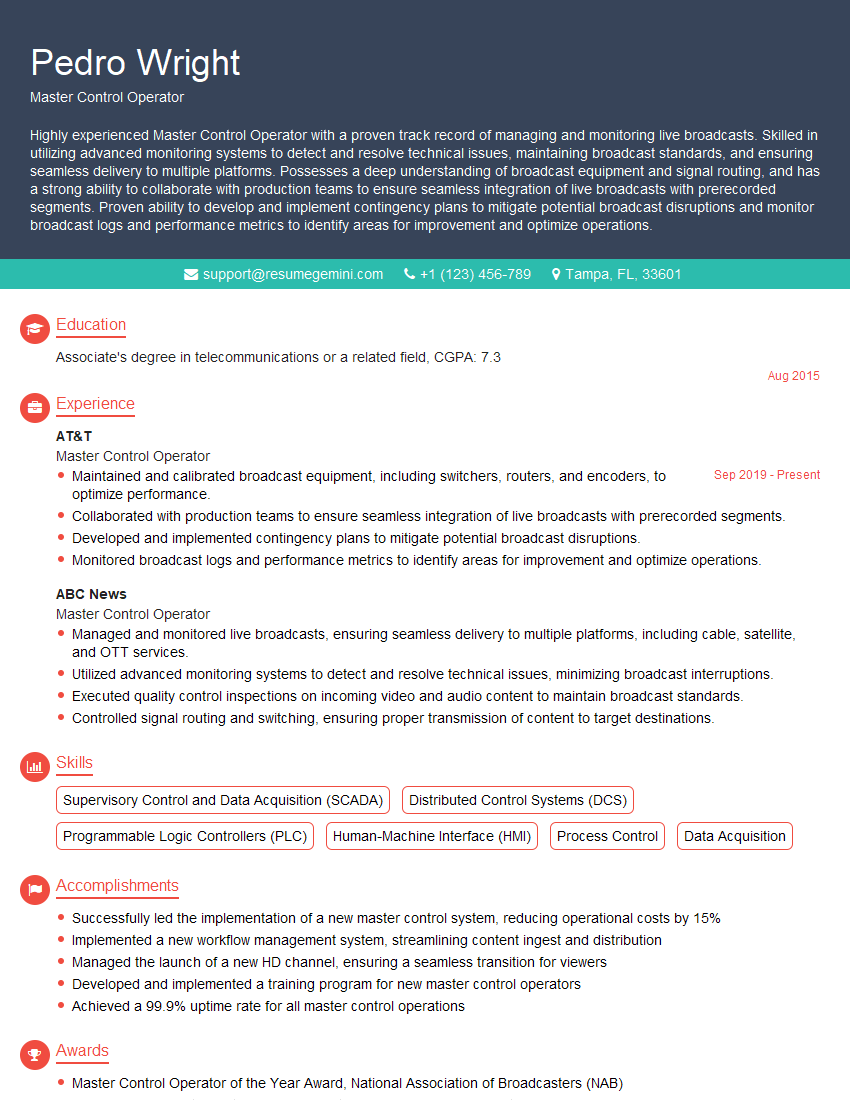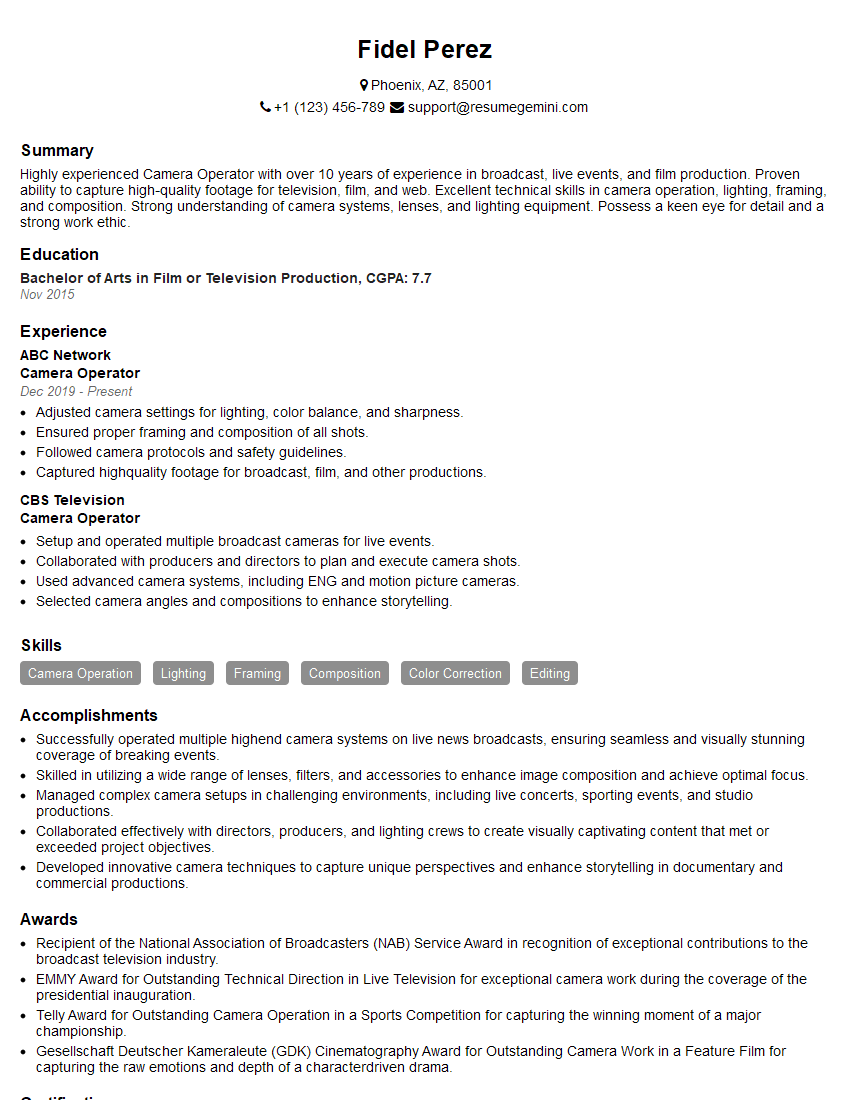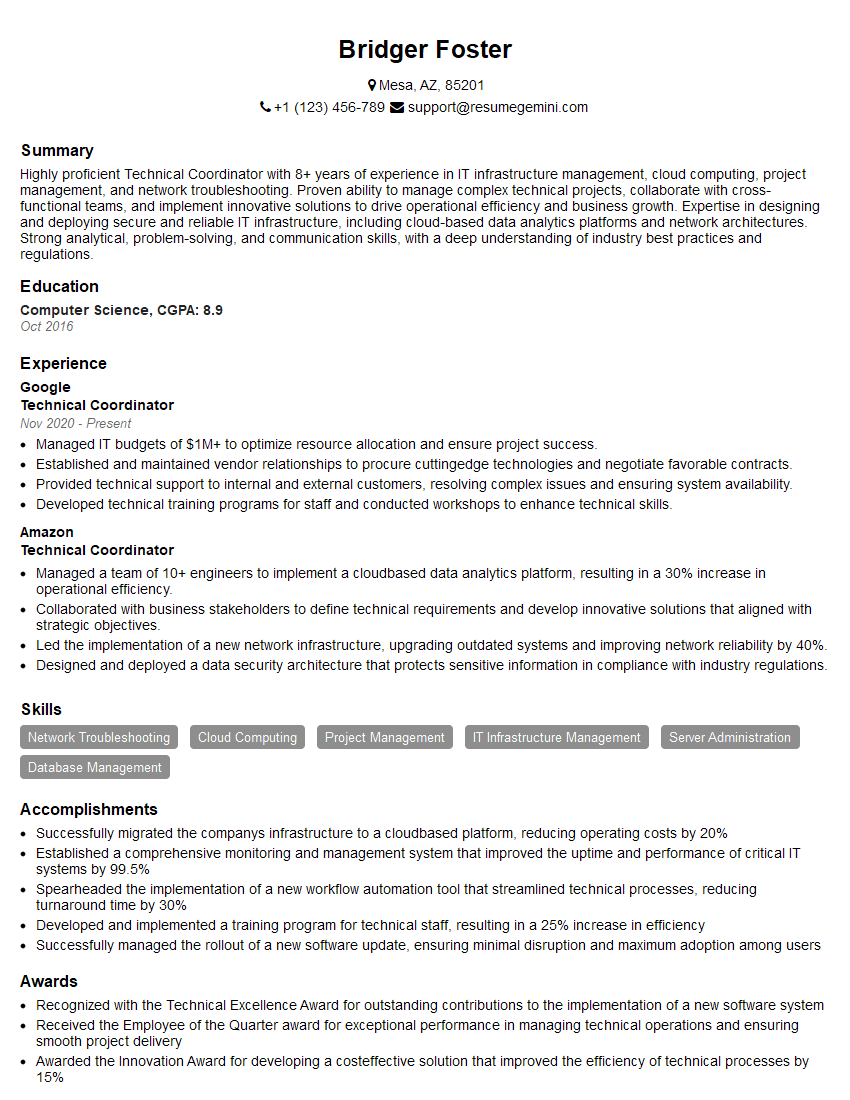Cracking a skill-specific interview, like one for Working with broadcast engineers and technicians, requires understanding the nuances of the role. In this blog, we present the questions you’re most likely to encounter, along with insights into how to answer them effectively. Let’s ensure you’re ready to make a strong impression.
Questions Asked in Working with broadcast engineers and technicians Interview
Q 1. Explain the difference between SDI and IP video signals.
SDI (Serial Digital Interface) and IP (Internet Protocol) are two fundamentally different ways of transmitting video signals. Think of SDI as a dedicated, high-speed highway directly connecting your video sources and destinations. It’s a point-to-point connection, offering excellent reliability and low latency, ideal for live broadcasts where timing is critical. IP, on the other hand, is like the internet – a packet-switched network. Video signals are broken down into data packets, routed across a network, and reassembled at the destination. This offers flexibility and scalability, allowing you to send video signals over existing IT infrastructure, but it can introduce latency and require more complex management.
- SDI Advantages: Low latency, high reliability, simpler setup for point-to-point connections.
- SDI Disadvantages: Less scalable, expensive for large-scale deployments, requires dedicated cabling.
- IP Advantages: Scalable, utilizes existing IT infrastructure, cost-effective for large networks.
- IP Disadvantages: Potential for higher latency, more complex setup and management, requires network expertise.
In practice, I’ve seen SDI used extensively in smaller studios and OB vans for its simplicity and reliability, while larger broadcasters and organizations utilizing extensive networks often prefer IP for its flexibility and cost-effectiveness in the long run. The choice often depends on budget, infrastructure, and the specific demands of the broadcast.
Q 2. Describe your experience with troubleshooting video and audio equipment.
My experience in troubleshooting video and audio equipment spans over a decade, encompassing a wide range of scenarios. From simple cable issues to complex system malfunctions, I’ve developed a systematic approach to diagnosis and resolution. For instance, I once resolved a sudden audio drop-out during a live news broadcast by identifying a faulty connection at a patch bay – a seemingly minor detail that was causing major disruption. I’ve also dealt with issues related to video sync, signal degradation, and equipment malfunctions. My troubleshooting typically involves:
- Visual Inspection: Checking for loose cables, damaged connectors, and obvious physical issues.
- Signal Tracing: Using monitoring tools to follow the signal path, identify points of failure, and isolate the problem area.
- Systematic Testing: Replacing components, cables, or equipment one at a time to pinpoint the source of the problem.
- Knowledge of Equipment Specifications: Understanding the specifications and operational parameters of different pieces of equipment.
- Log Analysis: Reviewing equipment logs to find errors and warnings.
I’m proficient in utilizing various test equipment, including waveform monitors, vectorscopes, and audio analyzers, to precisely diagnose problems and ensure the broadcast quality remains consistent.
Q 3. What are your troubleshooting methods for resolving signal loss in a live broadcast?
Signal loss in a live broadcast is a critical issue requiring immediate attention. My approach involves a structured, prioritized troubleshooting methodology:
- Identify the Scope of the Problem: Determine which signals are affected, and where the loss occurs (e.g., source, cable, switcher, receiver).
- Check the Obvious: Inspect cables and connections for physical damage, loose connections, or incorrect patching. This often solves the simplest issues.
- Isolate the Problem Area: Trace the signal path using monitoring tools, checking signal levels and quality at each point. This might involve using a signal generator to test specific parts of the signal chain.
- Investigate Equipment: Check for error messages, warnings, or unusual behavior on affected equipment. Look for signs of overheating or malfunction.
- Substitute Components: If possible, temporarily replace suspected faulty components (e.g., cables, converters) with known good ones to confirm the issue.
- Consult Documentation and Support: Refer to manufacturer manuals and technical specifications, or contact support for guidance if necessary.
- Implement Redundancy: If time permits, switch to a backup system or signal source to maintain the broadcast while troubleshooting the main issue. Many professionals use redundant systems for exactly this reason.
In a high-pressure live environment, prioritizing speed and efficiency is crucial. Years of experience have taught me to quickly assess the situation, focus on the most likely causes, and resolve the issue with minimal disruption to the broadcast.
Q 4. How familiar are you with various audio mixing consoles and their functionalities?
I’m highly familiar with various audio mixing consoles, ranging from smaller, compact models to large, sophisticated broadcast consoles from manufacturers like Yamaha, SSL, and Avid. My experience includes working with both analog and digital consoles, and I understand the functionalities of various components including:
- Input Channels: Understanding gain staging, equalization (EQ), dynamics processing (compression, limiting, gating), and aux sends.
- Busses: Master bus, group busses, and aux busses for routing audio signals.
- Output Section: Master level control, metering, and monitoring.
- Automation and Recall: Saving and recalling scenes for repeatable setups.
- Digital Audio Workstations (DAWs) Integration: Connecting and controlling DAWs for more complex audio processing.
For example, I’m experienced with utilizing Yamaha CL series consoles for their intuitive interface and powerful routing capabilities, and I’m proficient in using SSL consoles for their renowned sound quality and precise control over dynamics. My knowledge extends to understanding the specific features and capabilities of each console to optimize sound quality and meet the unique requirements of different broadcast productions.
Q 5. Explain your understanding of different video formats (e.g., HD, UHD, 4K).
Different video formats represent varying resolutions and aspect ratios, impacting the quality and detail of the image. Here’s a breakdown:
- HD (High Definition): Commonly refers to 720p (1280×720 pixels) and 1080i/1080p (1920×1080 pixels). 1080p offers better image quality than 720p.
- UHD (Ultra High Definition) / 4K: Typically refers to 3840×2160 pixels, providing four times the resolution of 1080p, resulting in significantly sharper and more detailed images.
- 8K: The next generation, with a resolution of 7680×4320 pixels, providing even greater detail, but requires significantly more bandwidth and processing power.
Understanding the implications of each format is critical for making informed decisions regarding camera selection, encoding settings, storage requirements, and broadcast transmission capabilities. Choosing the right format involves balancing image quality with bandwidth constraints and the capabilities of the broadcasting infrastructure.
Q 6. Describe your experience with various video switchers and their operations.
My experience encompasses a wide range of video switchers, from small production switchers to large, sophisticated broadcast switchers from manufacturers such as Ross Video, Grass Valley, and ATEM. I’m proficient in their operation, including:
- Source Selection: Routing video sources to various outputs.
- Transition Effects: Utilizing different transition effects like cuts, dissolves, wipes, and key effects.
- Keying: Layering graphics or video sources on top of other video sources.
- Mix Effects: Controlling the visual composition of the program output.
- Multiviewers: Monitoring multiple video sources simultaneously.
- Macros and Automation: Creating and executing complex sequences of commands.
For example, I’m adept at utilizing Ross Video switchers for their robust feature set and reliable performance in live broadcast environments. I’ve also worked extensively with ATEM switchers, appreciating their cost-effectiveness for smaller productions. Understanding the capabilities and limitations of different switchers is essential for choosing the optimal equipment for specific broadcasting needs. I understand their integration with other broadcast equipment and how to maximize their functionality to achieve seamless production.
Q 7. How do you ensure quality control in a broadcast environment?
Ensuring quality control in a broadcast environment is paramount. My approach incorporates several key strategies:
- Pre-Production Checks: Thorough checks of all equipment and signal paths before the broadcast begins. This includes testing cameras, audio levels, and video signals to ensure everything is functioning correctly.
- Monitoring During Broadcast: Continuous monitoring of video and audio levels, signal quality, and overall program output using waveform monitors, vectorscopes, and audio meters. This allows for prompt detection and correction of any issues.
- Using Test Patterns and Calibration: Regularly employing test patterns and calibration tools to maintain consistent image quality and color accuracy.
- Recording and Review: Recording the broadcast for later review to identify any technical or quality issues that may have gone unnoticed during the live broadcast.
- Using Redundant Systems: Having backup equipment available in case of failure, ensuring uninterrupted broadcast.
- Collaboration and Communication: Working closely with other members of the broadcast team (camera operators, audio engineers, directors) to ensure everyone is aware of any potential problems and is working towards maintaining the highest quality broadcast.
Proactive quality control minimizes errors and guarantees a professional and high-quality broadcast for the viewers. A systematic approach coupled with meticulous attention to detail is key.
Q 8. What are your experiences with remote broadcast operations?
My experience with remote broadcast operations is extensive, encompassing various roles from technical support to lead engineer. I’ve worked on projects utilizing both satellite and IP-based contribution feeds, managing remote crews and ensuring seamless integration with studio production. For instance, I was responsible for overseeing a live news report from a remote location during a major weather event. This required coordinating multiple communication channels, troubleshooting connectivity issues in real-time, and ensuring high-quality audio and video delivery despite challenging conditions. This involved utilizing specialized codecs, optimizing bandwidth usage, and implementing robust redundancy measures to mitigate risk. Another example includes managing a remote studio setup for a daily talk show utilizing cloud-based workflows, requiring meticulous planning and coordination for successful daily operations.
- Experience with various remote contribution technologies (satellite, fiber, IP).
- Proficient in troubleshooting and resolving connectivity issues.
- Skilled in optimizing bandwidth utilization and maintaining high-quality signal transmission.
- Experience managing and coordinating remote crews.
Q 9. Describe your familiarity with broadcast automation systems.
My familiarity with broadcast automation systems is comprehensive. I’ve worked extensively with systems such as [mention specific systems e.g., Grass Valley Ignite, Ross Overdrive, etc.], configuring and operating them for various applications, including news, sports, and general entertainment programming. I understand the intricacies of playlist creation, scheduling, and monitoring, and can troubleshoot issues ranging from simple script errors to complex system malfunctions. For example, I once resolved a critical system failure during a live news broadcast by quickly identifying a faulty database connection, implementing a temporary workaround, and preventing significant on-air disruption. The experience highlighted my understanding of system architecture and quick thinking under pressure.
- Experience with scheduling and playlist management.
- Proficient in troubleshooting and resolving system errors.
- Understanding of database integration and system architecture.
- Ability to implement temporary workarounds during critical situations.
Q 10. How do you handle pressure during live broadcasts?
Handling pressure during live broadcasts is a crucial aspect of my role, and I’ve developed effective strategies to manage it. My approach involves meticulous preparation, proactive problem-solving, and a calm, focused demeanor. Before any live event, I conduct thorough checks of all equipment and systems to minimize the likelihood of unexpected issues. During broadcasts, I maintain clear communication with the team and prioritize tasks based on urgency and impact. I remember one instance where a crucial piece of equipment failed just minutes before a major sporting event was due to go live. By quickly assessing the situation, coordinating with the team, and implementing a backup plan, we were able to avoid any significant on-air disruption and deliver the broadcast successfully. This experience strengthened my ability to work effectively under stress and demonstrate leadership in a crisis.
- Methodical approach to pre-broadcast preparations.
- Proactive problem-solving and contingency planning.
- Effective communication and teamwork.
- Calm and focused demeanor under pressure.
Q 11. Explain your experience with video servers and playout systems.
My experience with video servers and playout systems is extensive. I’ve worked with various platforms, including [mention specific systems e.g., Harris Nexio, EVS, etc.], managing content ingest, playback, and archiving. I understand the importance of efficient workflow design and have implemented optimized processes to streamline operations and maximize resource utilization. For example, I designed and implemented a new workflow for managing video assets, resulting in a significant reduction in processing time and improved efficiency. This involved integrating multiple systems, optimizing storage configurations, and developing customized scripts to automate tasks. This not only saved time but also reduced operational costs and improved overall quality control.
- Experience with various video server and playout systems.
- Proficient in content ingest, playback, and archiving.
- Expertise in workflow design and optimization.
- Ability to integrate multiple systems and automate tasks.
Q 12. Describe your knowledge of digital audio workstations (DAWs).
My knowledge of Digital Audio Workstations (DAWs) is strong. While not my primary focus, I am proficient in using various DAWs, such as [mention specific DAWs e.g., Pro Tools, Logic Pro, etc.], for audio editing, mixing, and mastering, particularly in the context of broadcast audio preparation. My experience extends to handling audio for both live and pre-recorded content, including applying various audio processing techniques like noise reduction, compression, and equalization to meet broadcast standards. For example, I frequently use DAWs to prepare audio stings and jingles for insertion during programming, ensuring seamless transitions and a consistent sound throughout the broadcast. I also use DAWs for basic sound design and audio sweetening for promotional materials.
- Proficient in using various DAWs for audio editing and processing.
- Experience with audio for both live and pre-recorded content.
- Understanding of broadcast audio standards and best practices.
- Ability to prepare audio stings and jingles for broadcast.
Q 13. What are your experiences with IP networking in broadcast environments?
My experience with IP networking in broadcast environments is substantial. I understand the principles of IP-based video transport, including protocols like SRT, NDI, and Zixi, and have implemented them in various projects. This includes designing and configuring networks for live contribution and distribution, ensuring reliable and low-latency transmission. For example, I played a key role in migrating a television station’s entire infrastructure to an IP-based network. This involved detailed network planning, device configuration, testing, and training staff on the new system. The transition resulted in a more flexible, scalable, and cost-effective infrastructure while maintaining broadcast quality and reliability.
- Experience with IP-based video transport protocols (SRT, NDI, Zixi).
- Proficient in network design and configuration for broadcast applications.
- Understanding of network security and QoS.
- Ability to troubleshoot and resolve network connectivity issues.
Q 14. How familiar are you with cloud-based broadcast workflows?
My familiarity with cloud-based broadcast workflows is growing rapidly. I’ve worked with various cloud platforms, including [mention specific cloud platforms e.g., AWS, Azure, Google Cloud], utilizing their services for storage, processing, and distribution of broadcast content. I understand the benefits of cloud-based workflows, such as scalability, cost-effectiveness, and accessibility, and have implemented cloud-based solutions for various tasks, including media asset management and live streaming. For example, I was involved in setting up a cloud-based live streaming system for a major conference, using cloud services to manage the ingest, encoding, and distribution of video feeds to a global audience. The experience highlighted my proficiency in configuring and managing cloud-based infrastructure and services for seamless broadcast delivery.
- Experience with various cloud platforms (AWS, Azure, Google Cloud).
- Understanding of cloud-based workflow design and implementation.
- Proficient in utilizing cloud services for media asset management and live streaming.
- Ability to troubleshoot and resolve cloud-related issues.
Q 15. Describe your understanding of RF transmission and reception.
RF transmission and reception involves the propagation of radio waves to transmit and receive signals. Think of it like throwing a ball – the transmitter is your hand, the radio wave is the ball, and the receiver is the person catching it. However, unlike a physical ball, the radio wave travels through the air (and sometimes other mediums) and carries information. The process begins with modulation, where information (audio, video) is encoded onto a carrier wave. This carrier wave, with its specific frequency, is then amplified and transmitted via an antenna. The receiving antenna captures the signal, and a receiver demodulates it, separating the information from the carrier wave. Signal strength, frequency, and interference greatly impact the quality of transmission and reception. For instance, a powerful transmitter can reach longer distances, but strong interference from other signals can cause noise and distortion. This is why careful frequency planning and the use of filters are crucial in broadcast engineering.
In a practical scenario, imagine a television broadcast. The television station’s transmitter modulates the video and audio onto a specific RF channel, transmitting it via a high-powered antenna. Your home TV’s antenna receives this signal, the receiver demodulates it, and you get your program. Understanding signal propagation, antenna design, and interference mitigation are essential for maintaining a reliable broadcast signal.
Career Expert Tips:
- Ace those interviews! Prepare effectively by reviewing the Top 50 Most Common Interview Questions on ResumeGemini.
- Navigate your job search with confidence! Explore a wide range of Career Tips on ResumeGemini. Learn about common challenges and recommendations to overcome them.
- Craft the perfect resume! Master the Art of Resume Writing with ResumeGemini’s guide. Showcase your unique qualifications and achievements effectively.
- Don’t miss out on holiday savings! Build your dream resume with ResumeGemini’s ATS optimized templates.
Q 16. How do you maintain broadcast equipment to prevent malfunctions?
Maintaining broadcast equipment involves a proactive and preventative approach. It’s not simply about fixing things when they break; it’s about anticipating potential problems. We start with regular inspections, checking for loose connections, overheating components, and signs of wear and tear. This includes visually inspecting cables, connectors, and equipment housings for any damage. Cleanliness is crucial – dust can cause overheating and malfunctions. Regular cleaning and the use of compressed air to remove dust buildup from sensitive components is vital. Beyond visual inspections, we utilize diagnostic tools and software to monitor performance parameters. For example, we might check signal strength and quality, audio levels, and power consumption. Calibration is also key. Regular calibration ensures accuracy and consistency in the equipment’s output.
Preventive maintenance also includes firmware and software updates. These updates often contain bug fixes and performance enhancements that prevent potential problems down the line. Finally, a well-maintained logbook documenting maintenance procedures, repairs, and any anomalies provides crucial information for troubleshooting and future planning. In essence, it’s a combination of careful observation, preventative measures, and proactive monitoring that keeps the broadcast going smoothly. Think of it like servicing your car – regular oil changes and inspections prevent major issues later on.
Q 17. Explain your experience with different camera systems and their operation.
My experience encompasses a range of camera systems, from traditional studio cameras to modern handheld and robotic systems. I’m proficient with both SD and HD cameras, including various manufacturers such as Sony, Panasonic, and Canon. Operating studio cameras involves understanding complex settings like color temperature, white balance, gain, and shutter speed. The adjustment of these parameters is critical for achieving optimal image quality. Working with handheld cameras demands agility and stability. I am proficient in using various camera supports, including tripods, steadicams, and gimbals, depending on the shoot’s requirements. Robotic cameras offer a higher degree of control, allowing for precise movements and camera positioning. I’m comfortable operating these systems, including programming automated camera movements for specific shots and effects.
For example, during a recent live broadcast, we used a combination of robotic cameras for wide shots and handheld cameras for dynamic close-ups. Understanding the strengths and limitations of each camera system is crucial in choosing the right equipment for the job and delivering high-quality visuals. My experience extends to working with various camera accessories like lenses, microphones, and viewfinders, enabling me to adapt to different shooting environments and scenarios. I also have experience with camera control units (CCUs) and understand how to remotely adjust camera settings during a live production.
Q 18. Describe your understanding of broadcast standards and regulations.
Broadcast standards and regulations are fundamental to ensuring consistent and high-quality broadcasts, as well as preventing interference and ensuring public safety. These standards cover many aspects, including audio and video formats, transmission frequencies, signal quality parameters, and legal compliance. For example, in television broadcasting, standards define the resolution (e.g., HD, 4K), aspect ratio, and frame rate. Compliance with these standards ensures interoperability between equipment from various manufacturers. In the audio realm, standards define things such as sample rates, bit depths, and compression techniques. Understanding these specifications is crucial for ensuring seamless integration and compatibility between different components of the broadcast chain.
Regulations, on the other hand, are governed by national and international bodies. They address issues like licensing, spectrum allocation, and content restrictions. For example, FCC regulations in the US govern broadcast frequencies and power levels, ensuring that different broadcasters don’t interfere with each other. These regulations also impose guidelines on content, such as limits on obscenity and violence. Adherence to both standards and regulations is essential to maintain a legal and technically sound broadcast operation. Failure to comply can result in fines or even suspension of the broadcast license. Therefore, keeping up-to-date with the latest standards and regulations is a continuous process that requires vigilance.
Q 19. How do you collaborate effectively with other broadcast professionals?
Effective collaboration is crucial in broadcast environments, which are often fast-paced and demanding. Clear communication is paramount. I believe in utilizing clear and concise language, avoiding jargon whenever possible, and actively listening to others’ viewpoints. Collaboration requires a willingness to share information and expertise. I often find that working effectively with others involves proactively sharing insights and assisting colleagues when needed, creating a supportive team environment. I’m comfortable working in diverse teams, and am always willing to adapt my communication style to ensure mutual understanding and effective teamwork.
Respecting the expertise of others is paramount. Recognizing the distinct roles and responsibilities within a broadcast team – such as camera operators, audio engineers, and directors – helps in assigning tasks efficiently and working towards a common goal. During a recent live sporting event, for example, effective communication between the camera operators, directors, and replay operators was essential in creating a fluid and engaging broadcast. I always make sure to contribute my own expertise while also valuing the contributions of others, ensuring a collaborative and effective outcome. This collaborative spirit is crucial to delivering high-quality broadcasts efficiently and successfully.
Q 20. What are your experiences with video encoding and decoding?
Video encoding and decoding are essential processes in broadcast workflows. Encoding converts raw video data into a compressed format suitable for transmission or storage. This compression reduces file sizes and bandwidth requirements. Various codecs (coder-decoder) are used, each with different compression levels and quality characteristics. Common codecs include H.264, H.265 (HEVC), and VP9. H.264 offers a good balance between compression and quality, while H.265 provides higher compression ratios, making it ideal for high-resolution video. Decoding is the reverse process, reconstructing the video from its compressed format. Effective encoding is crucial for maintaining a high-quality picture while minimizing bandwidth usage. The choice of codec depends on various factors, including the desired quality, available bandwidth, and processing power.
For instance, when streaming live video over the internet, we might use H.264 due to its wide compatibility and relatively efficient encoding. For archival purposes or high-resolution video delivery, H.265 might be preferred. Understanding different codecs, their strengths, and limitations is vital for making informed decisions about how to handle video data in broadcast applications. Moreover, I have hands-on experience with encoding and decoding software and hardware, enabling me to optimize workflows and troubleshoot encoding-related issues during live broadcasts or post-production.
Q 21. Explain your knowledge of various audio codecs.
Audio codecs are algorithms that compress and decompress audio signals. Similar to video codecs, they balance file size and audio quality. A wide range of codecs are used, each suited for different applications. Lossy codecs, like MP3 and AAC, discard some audio data during compression to reduce file size. These are commonly used for streaming music or broadcasting where a slight loss in quality is acceptable for bandwidth savings. Lossless codecs, like WAV and FLAC, maintain the original audio data, preserving quality but resulting in larger file sizes. They are used in situations where preserving the highest fidelity is essential, such as in audio mastering or archiving.
In broadcast audio, the choice of codec depends on the specific application and available bandwidth. For example, AAC is often used for digital radio broadcasting, offering a balance between compression and audio quality. In professional studio settings, uncompressed or lossless formats like WAV are often preferred for high-fidelity recordings. I have practical experience with various audio editing software and hardware capable of working with numerous codecs. This enables me to handle audio processing, encoding, and mixing in diverse broadcasting applications, ensuring quality audio output in all situations. Understanding the nuances of different audio codecs is critical for making informed decisions about managing audio in broadcast environments.
Q 22. Describe your understanding of signal routing and distribution.
Signal routing and distribution is the backbone of any broadcast operation. It’s the process of getting audio and video signals from their source (like a camera or microphone) to their destination (like a transmitter or monitor). Think of it like a complex highway system, guiding signals to their correct destinations efficiently and reliably. This involves numerous pieces of equipment, including routers, switchers, and distribution amplifiers.
- Routers: These are the central hubs, selecting which signals go where. They manage the flow of signals based on instructions from the control room.
- Switchers: Used for selecting between different video sources, allowing for seamless transitions between cameras, graphics, and other inputs during live broadcasts.
- Distribution Amplifiers: These take a single signal and create multiple identical copies, sending them to various destinations simultaneously without signal loss. For instance, you might need several copies of the main program feed to send to different studios, monitors, or transmitters.
A well-designed routing system ensures that signals reach their destinations with minimal delay and loss of quality. Effective routing is crucial for avoiding signal dropouts, ensuring correct signal levels, and maintaining high-quality broadcast output.
For example, in a live sports broadcast, the video router ensures that the correct camera angle is fed to the main program output, while the audio router mixes the various audio sources – commentators, crowd noise, and sound effects – to create a cohesive sound experience.
Q 23. How do you troubleshoot issues with audio latency?
Troubleshooting audio latency (delay) requires a systematic approach. Latency is the time delay between the audio signal’s generation and its reception. Even a small delay can disrupt the synchronization between audio and video, ruining the viewer experience.
My approach involves:
- Identify the source: Is the latency present in one specific source or across multiple sources? This helps narrow down the problem area (microphone, mixer, processing units, network devices, etc.).
- Measure the latency: Use specialized audio analysis tools to precisely measure the delay. This provides a quantifiable value to track progress and compare results after making adjustments.
- Check signal path: Examine the entire audio signal chain, from the microphone to the output. Look for long cable runs (longer cables introduce more latency), digital processing delays (certain effects or codecs might introduce added delay), and network congestion (in networked audio systems, network latency can be a significant factor).
- Examine equipment settings: Verify buffer sizes, sample rates, and other settings on all audio equipment. Incorrect settings can significantly affect latency.
- Test with alternate equipment: If possible, substitute components in the signal path (e.g., using a different cable or audio interface) to isolate problematic equipment.
For instance, if I suspect a network issue is causing latency in a networked audio system, I’d analyze the network traffic using tools like Wireshark to identify bottlenecks or congestion. By systematically examining each element of the signal path, you can pinpoint the cause of the latency and resolve the issue efficiently.
Q 24. How familiar are you with different types of microphones and their applications?
I’m very familiar with a wide variety of microphones and their applications. Choosing the right microphone is critical for capturing high-quality audio in broadcast settings. The microphone selection depends heavily on the sound being captured, and the environment.
- Dynamic Microphones: These are robust, handle high sound pressure levels well, and require less amplification than condensers. They are ideal for loud environments like live concerts or sporting events.
- Condenser Microphones: Highly sensitive, capturing subtle nuances in sound, making them perfect for studio recordings, voice-overs, or situations requiring a more detailed audio pickup.
- Ribbon Microphones: Known for their warm, smooth sound, often used for capturing instruments or vocals requiring a vintage or classic character.
- Shotgun Microphones: Highly directional, perfect for picking up audio from a distance, minimizing background noise. Commonly used in film and television productions.
- Lavaliere Microphones (Lapel Mics): Small and discreet, ideal for interviews or situations where a visible microphone would be intrusive.
I have extensive experience in selecting and placing mics to achieve the best possible audio quality considering factors such as proximity effect (bass boost caused by being too close), background noise, and acoustic environment. For example, in a live news interview outside, I might choose a shotgun microphone to focus on the interviewee, minimizing distracting street noises.
Q 25. Describe your experience with monitoring and analyzing broadcast signals.
Monitoring and analyzing broadcast signals is crucial to ensure quality and compliance. This involves using a range of tools and techniques to observe the signal at different points in the broadcast chain.
My experience includes using:
- Vectorscopes: Used to analyze color saturation and hue, ensuring accurate color representation.
- Waveform Monitors: Used to check audio levels and identify potential clipping or distortion.
- Audio Level Meters: Critical for ensuring appropriate audio levels to avoid distortion or excessive background noise. Proper use of peak and average metering is vital.
- Spectrum Analyzers: Analyzing the frequency response of the audio or video signal, allowing the detection of interference or unwanted frequencies.
- Signal Generators: Useful for testing equipment and signal pathways by inserting test signals and monitoring the response.
Regular monitoring allows for proactive identification and resolution of signal issues before they affect the broadcast. For instance, if a waveform monitor shows clipping (audio signal exceeding the maximum level), I can adjust the audio levels to prevent distortion in the transmitted signal.
Q 26. What are your experience with graphics generation and integration into a broadcast?
My experience with graphics generation and integration involves using various software and hardware solutions to create and incorporate visual elements into a broadcast. This can include lower thirds (displaying speaker names), scoreboards, animated logos, and virtual sets.
My work has encompassed:
- Character generators (CG): These systems create and display text and graphics overlays directly onto the video signal.
- Graphics workstations: High-powered computers used for creating complex 2D and 3D graphics.
- Video servers: These store and playback pre-recorded graphics and video clips, often used for promos or program bumpers.
- Virtual studio systems: Creating virtual sets using computer-generated imagery, often blended with live-action footage.
In a live sports broadcast, I might use a CG system to generate a real-time scoreboard that automatically updates as the game progresses. Successful integration requires coordinating graphics timing with the program flow to ensure a seamless and professional visual experience for the viewer. Proper timing and synchronization are crucial.
Q 27. Explain your approach to solving complex technical problems in a time-sensitive environment.
Solving complex technical problems under pressure requires a structured and methodical approach. My strategy involves:
- Rapid Assessment: Quickly gather information to understand the problem’s scope and impact. What systems are affected? What are the consequences of downtime?
- Prioritization: If multiple problems exist, prioritize based on impact and urgency. Focus on fixing the most critical issues first.
- Systematic Troubleshooting: Employ a structured approach, using elimination techniques. Test each component or section of the system to isolate the fault. Document your findings at each step.
- Collaboration: Don’t hesitate to seek assistance from colleagues. A fresh perspective can often help identify solutions you might have missed.
- Workarounds: If a complete fix isn’t immediately possible, implement temporary workarounds to minimize disruption.
- Post-mortem Analysis: After resolving the problem, review the process to identify areas for improvement and prevent future occurrences. This is important for continuous learning and improvement.
For example, during a live broadcast, if a camera fails, I might quickly switch to a backup camera while simultaneously troubleshooting the faulty equipment to determine the cause of the failure and get it repaired or replaced as quickly as possible.
Q 28. How do you stay up-to-date with the latest broadcast technologies?
Staying current in broadcast technology is paramount. I actively use several methods to remain updated:
- Professional Organizations: Membership in organizations like the Society of Broadcast Engineers (SBE) provides access to industry publications, conferences, and networking opportunities.
- Trade Publications and Websites: Regularly reading industry magazines and visiting specialized websites keeps me informed of the latest advancements.
- Conferences and Workshops: Attending industry events provides valuable insights into new technologies and best practices.
- Online Courses and Webinars: Numerous online resources offer training on various aspects of broadcast technology, from software updates to new equipment.
- Hands-on Experience: The best way to stay current is by actively working with new technologies and experimenting with different setups.
Continuous learning is crucial in this rapidly evolving field. New technologies, standards, and workflows are constantly emerging, and staying up-to-date is key to maintaining a competitive edge.
Key Topics to Learn for Working with Broadcast Engineers and Technicians Interviews
- Understanding Broadcast Equipment: Familiarize yourself with common broadcast equipment like cameras, audio mixers, switchers, and transmission systems. Consider their functionalities and limitations.
- Workflow and Collaboration: Learn about the typical workflow in a broadcast environment and the importance of effective communication and collaboration with engineers and technicians. Practice describing your collaborative skills and problem-solving approaches in team settings.
- Technical Troubleshooting: Develop a basic understanding of troubleshooting common technical issues in broadcasting. This could involve identifying problems, escalating issues appropriately, and documenting solutions.
- Broadcast Standards and Regulations: Gain familiarity with relevant broadcast standards (e.g., audio levels, video formats) and regulatory compliance aspects. This demonstrates a commitment to professional best practices.
- Health and Safety Protocols: Understand the importance of adhering to health and safety guidelines in broadcast environments, including equipment handling and studio procedures.
- Project Management Basics: Even in a support role, understanding project timelines, resource allocation, and basic project management principles can be beneficial.
- Technical Terminology: Build your vocabulary related to broadcast technology. Being able to confidently use and understand technical terms shows your commitment to the field.
Next Steps
Mastering the art of working with broadcast engineers and technicians is crucial for a successful and rewarding career in the dynamic world of broadcasting. Strong collaboration skills and technical understanding are highly valued by employers. To increase your chances of landing your dream job, creating a compelling and ATS-friendly resume is paramount. ResumeGemini can help you craft a professional and impactful resume tailored to highlight your relevant skills and experience. We provide examples of resumes specifically designed for candidates working with broadcast engineers and technicians to help you create a truly outstanding application.
Explore more articles
Users Rating of Our Blogs
Share Your Experience
We value your feedback! Please rate our content and share your thoughts (optional).
What Readers Say About Our Blog
Hi, I represent an SEO company that specialises in getting you AI citations and higher rankings on Google. I’d like to offer you a 100% free SEO audit for your website. Would you be interested?
Dear Sir/Madam,
Do you want to become a vendor/supplier/service provider of Delta Air Lines, Inc.? We are looking for a reliable, innovative and fair partner for 2025/2026 series tender projects, tasks and contracts. Kindly indicate your interest by requesting a pre-qualification questionnaire. With this information, we will analyze whether you meet the minimum requirements to collaborate with us.
Best regards,
Carey Richardson
V.P. – Corporate Audit and Enterprise Risk Management
Delta Air Lines Inc
Group Procurement & Contracts Center
1030 Delta Boulevard,
Atlanta, GA 30354-1989
United States
+1(470) 982-2456
